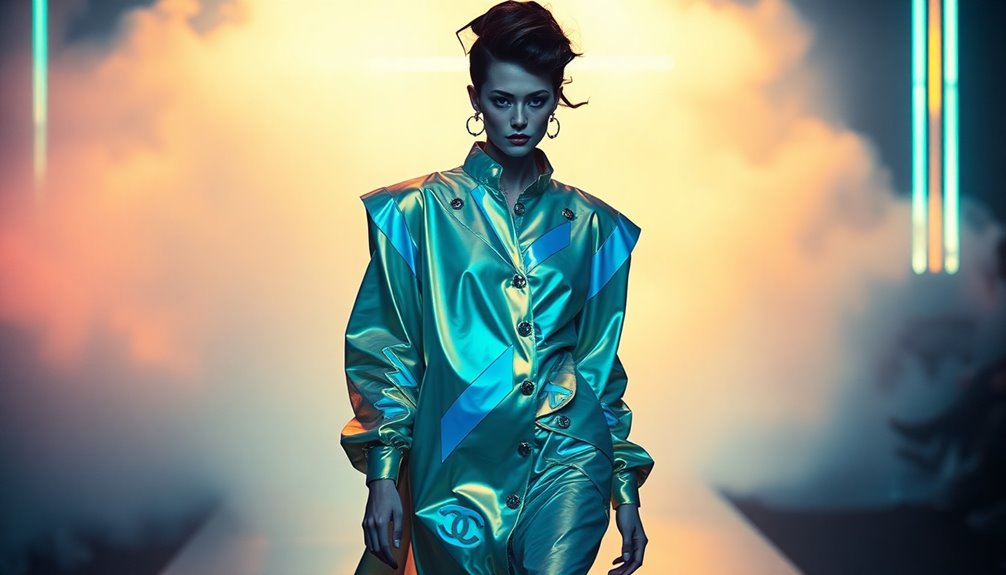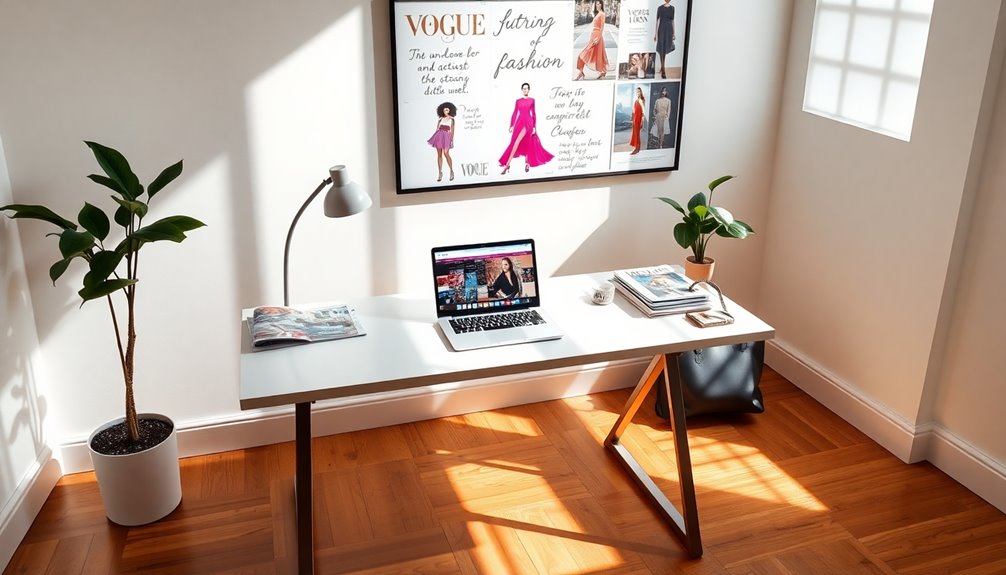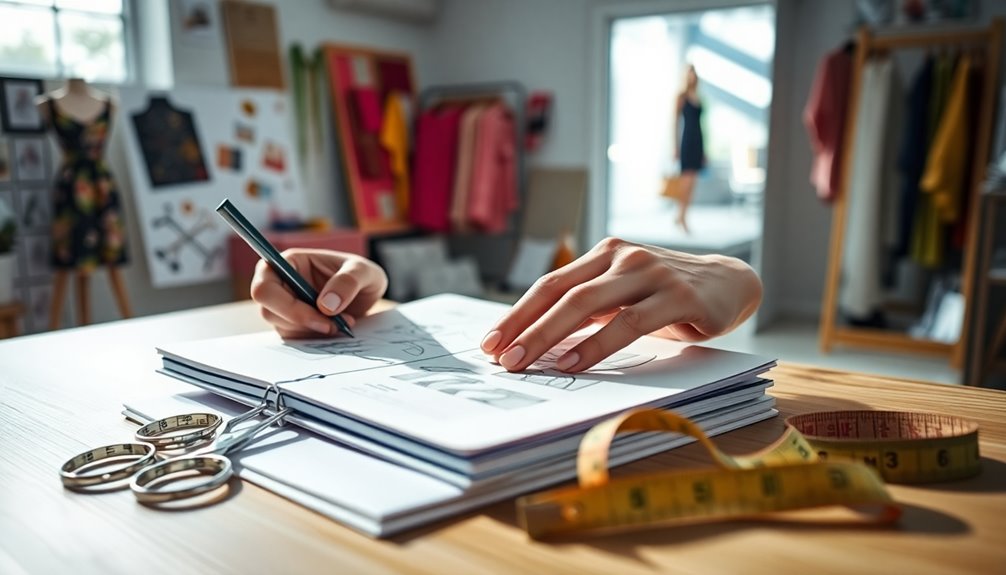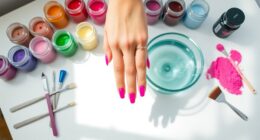In a fashion company, you'll find key departments that drive creativity and functionality. The Fashion Design Department focuses on trends and aesthetics, while Product Development transforms designs into real items. Production and Manufacturing ensure quality and efficiency. Merchandising and Buying manage product assortments and supplier relationships. You've also got the Styling Department and Visual Communication teams that shape brands through engaging visuals. Marketing Strategies are crucial for reaching audiences and driving sales. Collaboration across these departments enhances innovation, and sustainability initiatives promote responsible practices. There's so much more beneath the surface that you'll want to explore further.
Key Takeaways
- The Fashion Design Department conducts research, creates mood boards, and develops detailed sketches and technical drawings for garments and accessories.
- Product Development transforms design concepts into tangible fashion items, collaborating with manufacturers for prototypes and focusing on quality control.
- Production and Manufacturing manage scheduling, resource coordination, and quality checks to ensure garments meet customer standards and minimize waste.
- Merchandising and Buying oversee product assortments, analyze sales data, and collaborate with teams to optimize inventory and pricing strategies.
- Visual Communication and Branding shape brand identity through styling, photography, graphic design, and narrative crafting to engage the target audience.
Fashion Design Department
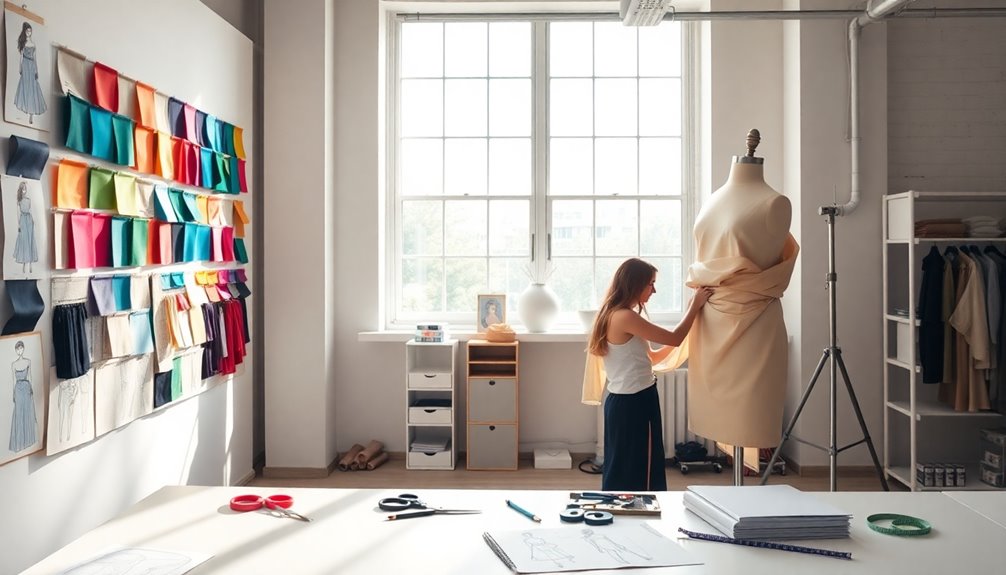
In a fashion company, the Fashion Design Department plays a crucial role in shaping the brand's identity and offerings. You start by conducting thorough research on trends, demographics, and cultural influences, allowing you to identify market trends and forecast design directions. Gathering inspiration, you create mood boards that establish the overall aesthetic of the brand. Analyzing industry reports informs your design decisions and helps you develop innovative, market-relevant concepts.
Once you've conceptualized ideas, you move on to design and sketching. You create detailed sketches and technical drawings of garments, accessories, and other fashion items. Using both traditional methods and digital tools, you translate concepts into visual representations, carefully selecting patterns, trims, and materials. This stage is essential for developing a design strategy and signature style for the line.
Fabric selection is next, where you choose the right materials that align with your design concepts. Collaborating with suppliers, you ensure that your fabric and trim selections meet the brand's aesthetic and quality standards. In addition, you must possess strong technical skills for garment construction to translate your creative ideas into tangible products.
Throughout this process, you manage and oversee the design journey, ensuring every detail aligns with the business strategy and current market trends.
Product Development

Product development is where creativity meets practicality, transforming design concepts into tangible fashion items. You start with conceptualization and design, visualizing ideas through mood boards and sketches. Your design team collaborates, brainstorming to create initial concepts that include colorways, fabric swatches, and trim details, all while researching the latest fashion trends and understanding your target market's needs.
Next, you move into sample making and prototyping, partnering with manufacturers to create the first version of the garment. You test the fit, construction, and finishes, revising the specification sheets based on feedback until you achieve the final approval. This stage is crucial, as it sets the groundwork for what comes next.
Collaboration and communication are vital throughout the process. You work closely with technical and design teams, ensuring everyone aligns on creative ideas, brand aesthetics, and quality standards. Additionally, you coordinate with the production and manufacturing team to address any potential challenges that may arise during the transition from design to final product.
Using digital tools helps you gain data-driven insights and develop virtual prototypes. Ultimately, your focus on quality control ensures satisfaction for both the fashion house and its consumers, as you monitor supplier performance and oversee the entire production line, guaranteeing timely and high-quality deliveries.
Production and Manufacturing
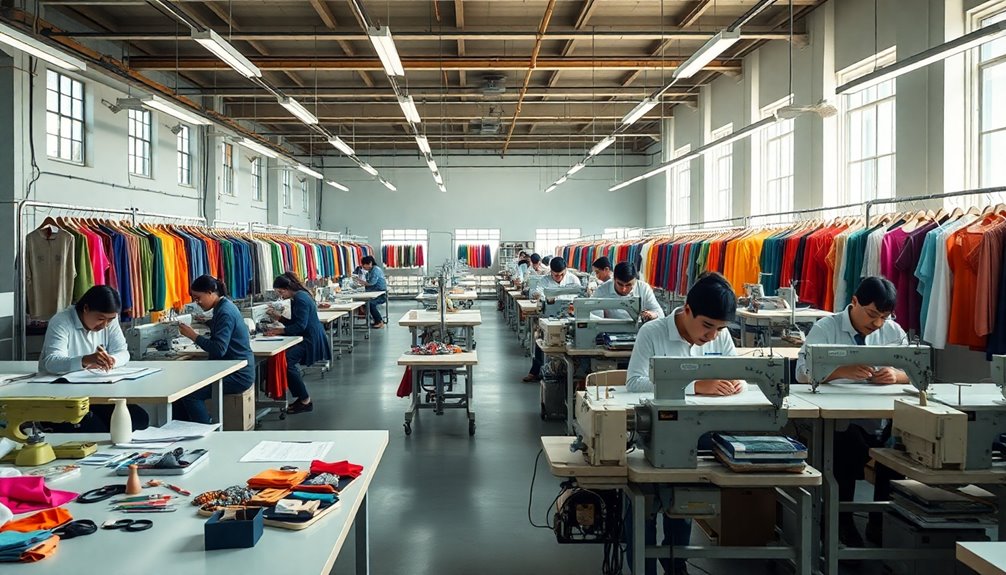
Managing production and manufacturing effectively is crucial for transforming design prototypes into finished garments ready for the market. You'll find that production planners play a key role in scheduling activities in advance, using time and action calendars to detail every step. They ensure that all necessary resources are available and coordinate with various departments to align production goals. Monitoring progress allows them to adjust plans as needed. Production planning is essential for measuring and optimizing clothing manufacturing processes, leading to better resource allocation and timely delivery of products.
Fabric sourcing is equally important, as it involves obtaining high-quality materials from trusted textile manufacturers. You'll see fabric development tailored to design specifications, with rigorous testing conducted in labs to ensure quality.
In the cutting department, methods like laser-cutting come into play to minimize fabric waste. As garments are assembled in the sewing department, quality control checks are vital to catch errors early.
After assembly, garment washing and finishing departments provide post-sewing treatments, while printing and embroidery departments add unique design elements. Finally, thorough inspections ensure that garments meet customer standards, with statistical process control monitoring production processes.
This attention to detail guarantees that what reaches the market isn't just stylish but also high-quality.
Merchandising and Buying

Bridging the gap between creative design and commercial success, the merchandising and buying departments play a pivotal role in a fashion company. You ensure that the right products are available at the right time and in the right quantities. This involves managing the intersection of creativity, market trends, and consumer demands.
Your responsibilities include curating product assortments, managing supplier relationships, optimizing inventory, and implementing pricing and promotion strategies. You monitor market trends, analyze sales data, and understand customer preferences to create compelling product ranges. Your ability to work under pressure during busy shipment days demonstrates the importance of fast-paced work environments in this role.
Collaborating closely with design and production teams, you select products that meet consumer needs and develop assortment plans that guide purchasing decisions. Building and maintaining relationships with suppliers is essential. You negotiate pricing, terms, and delivery schedules to secure the best deals while ensuring quality.
Inventory management is also crucial; by overseeing replenishment and allocation, you maintain optimal stock levels. Finally, you utilize budget planning and analyze performance data to inform future strategies, ensuring the right depth and number of options are available at the correct retail price.
In doing so, you directly impact a brand's success in the competitive fashion landscape.
Styling Department

In a fashion company’s styling department, your creative vision shapes how the brand’s products are perceived and presented to the world. Your role involves curating looks that resonate with the brand’s voice and enhancing products for appealing presentation across various media. Additionally, you will work closely with photographers, models, and other team members to execute photo shoots and fashion shows. Your expertise in trend analysis and consumer behavior will also play a key role in ensuring the brand remains relevant and competitive in the market. Avoiding common fashion resume mistakes such as lack of detail or failure to highlight relevant experience will be essential in standing out as a top candidate for this exciting role.
You'll collaborate closely with designers to maintain consistency in the brand's aesthetic, selecting and coordinating accessories, props, and models for photo shoots and fashion shows. As a stylist, you work with assistants and fashion coordinators, making sure all logistical elements align perfectly.
Your process begins with reviewing design concepts to grasp the brand's direction. You'll plan and prepare for photo shoots, coordinating efforts with other departments like design and marketing. Fittings are crucial, as you make necessary adjustments for optimal presentation, ensuring that everything aligns with the brand's identity. Collaborating with design teams is essential to ensure that styling complements the overall collection theme.
To thrive in this role, you need a strong understanding of current fashion trends, effective communication skills, and a keen eye for detail. Strong organizational skills help you manage multiple projects simultaneously, while knowledge of styling techniques, lighting, and photography enhances the overall product presentation that captivates your audience.
Visual Communication
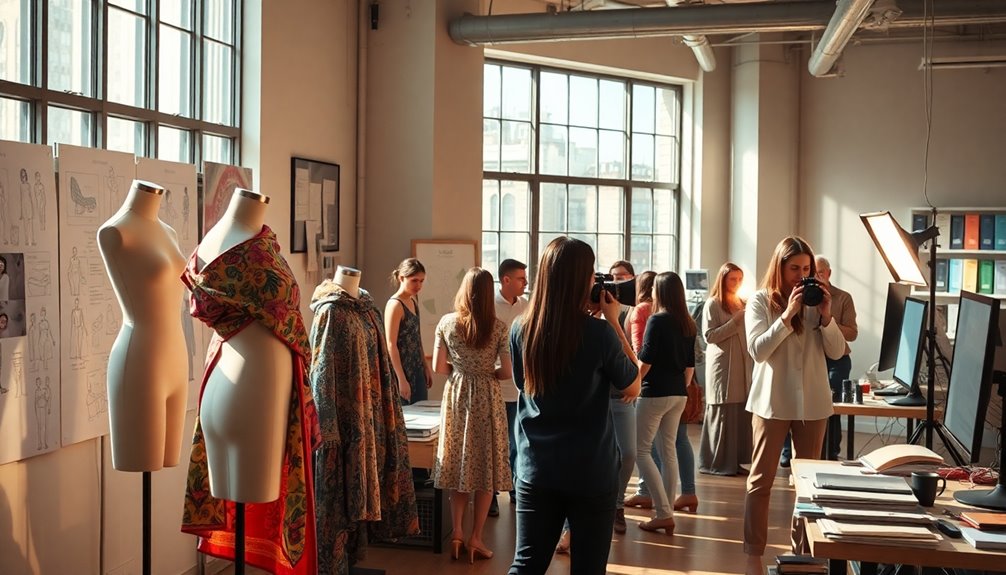
The styling department lays the groundwork for how a fashion brand communicates its identity, but visual communication takes this a step further by amplifying that message through impactful imagery and design. This crucial department includes photography, graphic design, and art direction, each playing a vital role in shaping the brand's visual narrative.
In the photography department, teams plan and execute photoshoots that bring the brand's vision to life. They collaborate closely with stylists and models, capturing high-quality images that resonate with the brand's aesthetic. Post-production editing ensures the final visuals align perfectly with the intended message.
Graphic design further strengthens brand identity by creating visual assets like logos, typography, and color schemes. This role ensures consistency across all marketing channels, utilizing industry software for high-quality content. Additionally, designers often engage in hands-on practice to enhance their technical skills, which is essential for effective visual communication.
Art directors oversee the entire creative direction, coordinating with other teams to maintain visual coherence. They're involved in planning campaigns and ensuring that every image reflects the brand's identity.
Together, these visual communication teams craft a compelling narrative, ensuring your brand stands out in a crowded market and resonates with its target audience across various platforms.
Marketing Strategies
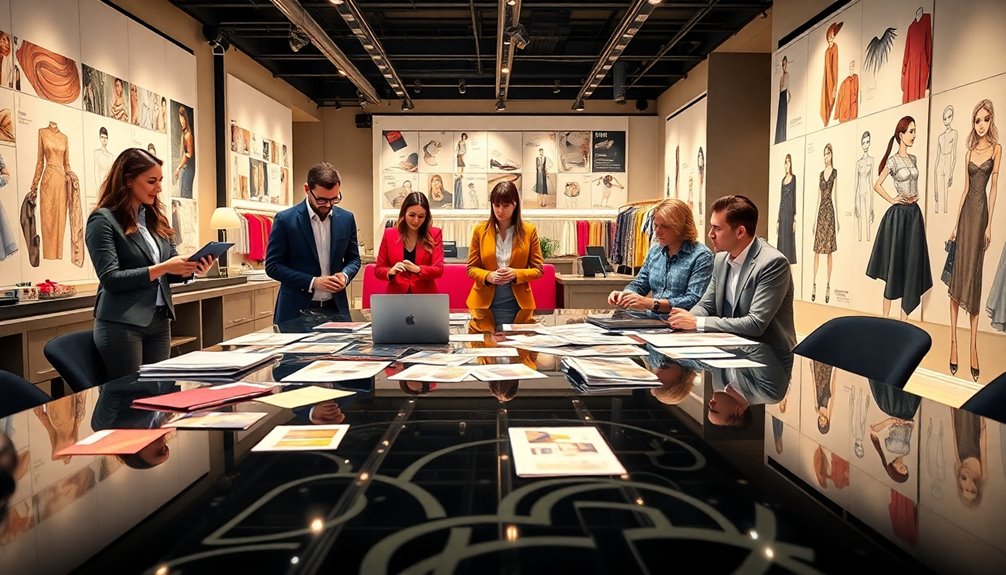
Marketing strategies are essential for fashion companies looking to carve out their niche in a competitive landscape. You'll want to focus on digital marketing to make a significant impact.
Start by engaging your audience on social media platforms like Instagram, Facebook, and TikTok. Collaborating with influencers can help you reach your target demographic effectively. Utilize social commerce features for direct purchasing and take advantage of live shopping opportunities to showcase your products in real-time.
To create urgency, implement limited-time offers that instill FOMO. Promotions such as "Free Shipping until 11:59 PM" or "15% OFF site-wide, today only" can drive quick sales. Additionally, consider how effective marketing strategy is crucial for brand success in the competitive fashion industry. Understanding targeted promotions can significantly enhance your reach and conversion rates.
Don't forget to retarget visitors with reminder ads to boost conversions. Engagement is key, so run contests and respond promptly on social channels.
Use data and AI to personalize customer experiences and enhance brand loyalty through tailored email marketing. Lastly, gather and analyze consumer data to refine your strategies continuously, ensuring you meet your audience's needs.
With these tactics, you'll optimize your marketing efforts and increase your brand's visibility in the ever-evolving fashion market.
Collaboration Across Departments

How can effective collaboration across departments elevate a fashion company's success? When design and product development teams work closely, they ensure that creative concepts align with market trends and consumer demands. This synergy leads to innovative products that resonate with shoppers.
Art directors, photographers, and stylists collaborate to craft compelling visual campaigns that capture attention and enhance brand identity. Moreover, merchandising and buying teams act as a bridge between creativity and commercial viability, facilitating communication to ensure the final products are market-ready.
Stylists and creative directors coordinate to select the right garments and accessories, ensuring fashion shows reflect the collection's theme. Collaborative tools like TUKAcloud streamline communication, allowing teams to manage design changes and deadlines efficiently. Additionally, fostering high employee engagement can lead to a 20% increase in productivity and profitability, further enhancing the company's success.
By fostering a collaborative environment, companies can accelerate product launches, improve accuracy in meeting client expectations, and create a culture of compassion and understanding among employees. While challenges exist in maintaining effective communication, especially in remote settings, embracing flexibility and inclusivity can turn these hurdles into opportunities for growth. Ultimately, collaboration across departments is vital for driving innovation and achieving business goals in the dynamic fashion industry.
Sustainability Initiatives
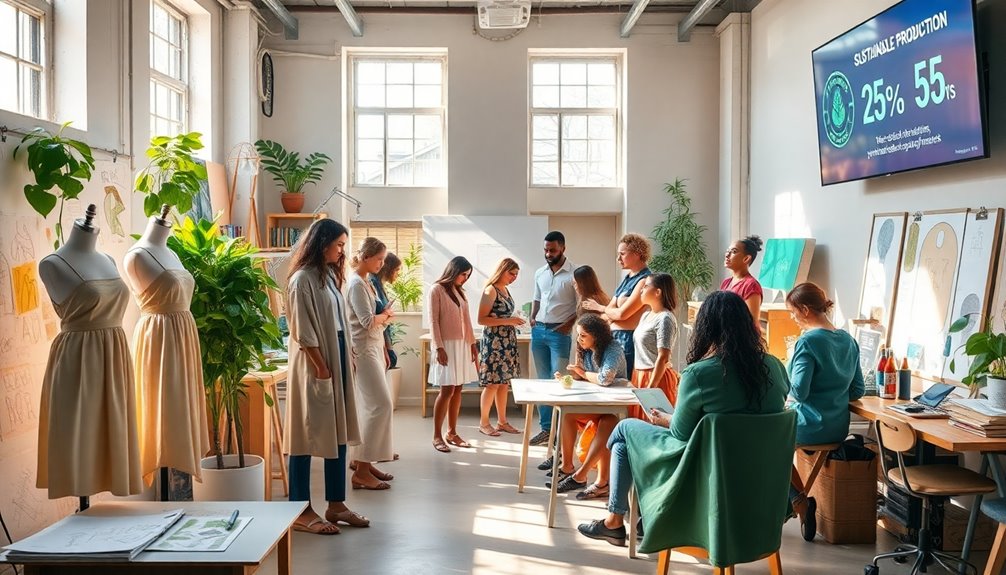
Embracing sustainability initiatives has become essential for fashion companies aiming to thrive in today's market. You'll find that responsible sourcing is at the forefront, with over 90% of materials like organic cotton and upcycled faux furs being sourced ethically.
Brands are innovating by using biodegradable rubber and vegan leather alternatives, such as mycelium-based options. Many companies, like Gucci, are transitioning to regenerative cotton and bio-based materials to enhance their product lines.
They're also making strides in renewable energy, with Vivienne Westwood aiming for 100% renewable energy by 2024 and Louis Vuitton targeting a 55% reduction in carbon footprint by 2030. Moreover, the fashion industry is under pressure to address its impact on the environment, as it currently accounts for approximately 10% of global carbon emissions.
Supply chain transparency is crucial, and brands like Gucci guarantee 95% traceability of their raw materials. However, only a small percentage disclose their supply chain's energy sources.
The shift toward a circular economy is gaining momentum, with initiatives focusing on waste reduction and the use of upcycled materials.
Frequently Asked Questions
How Do Fashion Companies Decide on Their Seasonal Themes?
Fashion companies decide on their seasonal themes by closely observing runway shows and emerging trends.
You'll notice they analyze color palettes, materials, and styles presented during major fashion weeks. They also consider consumer behavior and market demand, ensuring that themes resonate with shoppers.
Collaborating with design teams, they gather inspiration and research to create cohesive collections.
This process allows them to adapt to external factors while staying aligned with current trends and customer preferences.
What Role Does Customer Feedback Play in Design Decisions?
Customer feedback plays a crucial role in your design decisions.
It helps you identify emerging trends by analyzing reviews, social media interactions, and purchasing patterns. You can enhance fit and comfort by refining sizing and addressing specific issues raised by customers.
Additionally, feedback reveals preferences for styles and features, driving innovation. By incorporating this input, you create designs that resonate with your audience, fostering loyalty and ensuring your brand stays relevant in the ever-changing fashion landscape.
How Are Emerging Trends Identified Before They Become Popular?
You identify emerging fashion trends by analyzing past and current data, like consumer surveys and sales figures.
Keep an eye on runway shows and street style to see what's gaining traction. Collaborating with industry experts and trend forecasters helps you anticipate shifts.
Additionally, consider cultural influences and social media impact.
What Qualifications Are Essential for a Career in Fashion Marketing?
To excel in fashion marketing, you'll need a solid educational background, typically a Bachelor's degree in marketing or a related field.
Strong communication and interpersonal skills are crucial for building relationships and conveying messages effectively.
Proficiency in digital tools and analytics is essential, as is creativity for developing compelling campaigns.
Additionally, social media management skills will help you engage with your audience and enhance brand awareness, making you a valuable asset in the industry.
How Do Fashion Brands Ensure Inclusivity in Their Collections?
To ensure inclusivity in their collections, fashion brands like yours focus on diverse representation in marketing, showcasing models of various ethnicities, ages, and body types.
You can implement gender-neutral designs that avoid traditional labels and create flattering clothing for all shapes.
By adopting adaptive features and using size recommendation tools, you cater to individual needs.
Engaging with customers through feedback and community involvement further enhances your commitment to inclusivity and authenticity.
Conclusion
In the world of fashion, each department plays a crucial role in bringing a brand to life. From design and production to marketing and sustainability, collaboration is key to success. Understanding how these departments work together helps you appreciate the artistry and effort behind your favorite pieces. So, next time you admire a collection, remember the dedicated teams behind the scenes, all working tirelessly to create the fashion you love. It's a vibrant dance of creativity and strategy!

